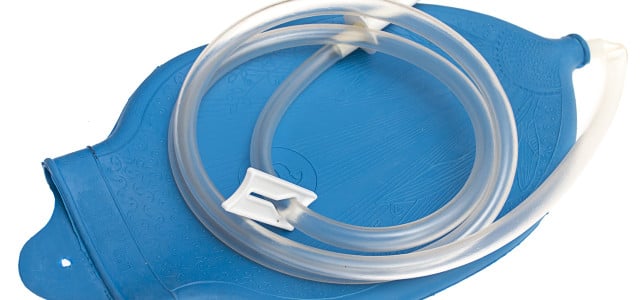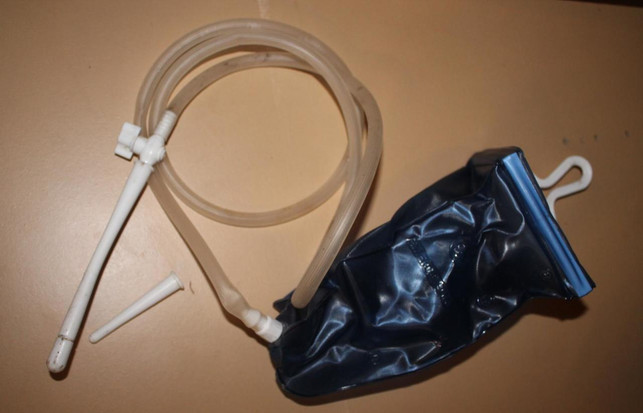
Colonic irrigation using an enema may be necessary in certain situations. However, we do not recommend doing the enema yourself – it is better to leave it to a medical professional.
In healthy people, the intestines cleanse themselves and colonic irrigation is not absolutely necessary. However, an enema can prove helpful in some situations. The purpose of a colonic irrigation is to empty or cleanse the intestines.
You can have a colon cleanse carried out by a medical professional, and you can also find instructions online on how to do it yourself at home. However, this involves serious risks, which is why we advise against it.
By the way: There is no scientific evidence that colonic irrigation detoxifies the body.
These devices are available for enemas
An enema involves introducing fluid into the intestines through the anus to stimulate bowel movements and cleanse the intestines. There are various tools that differ in how they are handled.
-
Irrigator: An irrigator consists of a container for the enema fluid, a hose and a tube with a valve. This tube is inserted a few centimeters into the anus. Up to two liters can be introduced with an irrigator. This enema device is also sold for home use.
-
Intestinal tube: The intestinal tube is an extension piece for the irrigator that is inserted up to 30 centimeters deep into the intestine. This so-called “high” enema works higher up in the digestive tract, but carries particular risks (see below).
-
Mini enema: These enema devices are designed for single use only and hold between five and 500 milliliters. These mini enemas are usually used to introduce hypertonic solutions or liquids containing medication. As with the irrigator, the end piece is inserted only a few centimeters deep and thus stimulates the rectum.
-
Enema syringe: An enema syringe either consists of a pear-shaped rubber bulb that holds up to 500 milliliters of liquid or is similar to a standard syringe (see picture). An enema tube is attached to it as an end piece, which is inserted a few centimeters into the anus.
Areas of application of the enema
An enema is primarily used to empty the intestines: the liquid introduced causes the intestines to empty quickly – usually within a few minutes. This is why the enema offers an effective remedy for acute constipation.
An enema can also be used to cleanse the intestines. In this context, it is often recommended in naturopathy to flush out old feces and prepare the intestines for upcoming intestinal cleansing. In addition, the enema is intended to flush out toxins, which is why colon cleansing is also said to help with headaches and colds and strengthen the immune system.
However, from a conventional medical perspective, such applications are controversial.
However, the enema is also used from time to time in conventional medicine, for example
- for stubborn constipation,
- with an increased potassium level,
- before delivery or
- to introduce medication through the anus.
This is how an enema works

(Photo: Pascal Thiele / Techzle\.com)
This is roughly how an enema works:
-
Liquid: An enema is usually carried out with water, preferably filtered or boiled beforehand. But enemas with chamomile or cumin tea or bentonite water (healing clay) are also common. Coffee enemas are sometimes also carried out, although their effect has not been scientifically proven.
- The end of the irrigator and the anus are greased with a little lubricant. When inserting it, it is important to proceed carefully and not jerkily.
-
Temperature: In any case, it is important that the liquid is lukewarm (around 36 to 37 degrees). If it is too cold, cramps can occur. Liquid that is too hot can cause serious injury.
-
Amount: The amount that can be absorbed varies depending on the condition of the intestines. Sometimes an unpleasant pressure occurs after just 200 milliliters, so-called peristaltic surges. Then another enema can be performed after the first bowel movement.
Make your own enema? That can happen
As useful as a self-administered enema can be, it can pose enormous risks if handled incorrectly:
-
Puncture or tear of the intestine: If you insert the irrigator tube incorrectly, you can damage the intestinal wall and sometimes even puncture it. This can lead to excessive rectal bleeding and, in worst cases, even death.
-
Scalding: If the enema fluid is too hot, you can burn yourself internally, which can cause lasting damage to the intestines.
-
Disturbance of electrolyte balance or intestinal flora
-
Infection caused by unhygienic enema devices or fluid
You should therefore definitely seek medical advice and have the enema carried out by trained specialists.
You should also not perform an enema in the following cases:
- pregnancy
- chronic intestinal diseases (e.g. Crohn’s disease)
- after colon surgery
- Bleeding in the digestive tract
- mechanical intestinal obstruction
- Colon cancer
- Vomiting without an established cause
In addition to the enema using an irrigator, there are also other alternatives to colon cleansing:
-
Colon hydrotherapy (CHT): CHT is a professional colon cleansing. It is particularly effective, but also very expensive at around 60 to 80 euros per treatment.
-
Laxatives: You can also use laxatives such as Glauber’s salt to empty the bowels.
-
Castor oil: Castor oil also has a strong laxative effect. Used over two days, it can completely empty the intestines.
-
Foods rich in fiber: If you have intestinal sluggishness and mild constipation, very high-fiber foods such as flax seeds or chia seeds can be enough to stimulate intestinal peristalsis.
Read more on Techzle\.com:
- Build up intestinal flora: This is how your intestines get fit again after antibiotic treatment
- Irritable bowel syndrome: irritable bowel syndrome, symptoms, which diet helps
- Stimulate digestion: These natural home remedies help
Revised by Lena Kirchner
** marked with ** or orange underlined Links to sources of supply are partly partner links: If you buy here, you are actively supporting Techzle\.com, because we then receive a small part of the sales proceeds. More info.